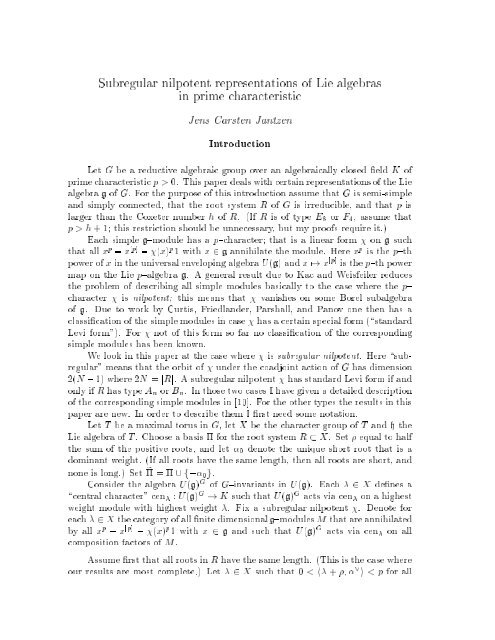subregular nilpotent representations of lie algebras in prime ...
subregular nilpotent representations of lie algebras in prime ...
subregular nilpotent representations of lie algebras in prime ...
You also want an ePaper? Increase the reach of your titles
YUMPU automatically turns print PDFs into web optimized ePapers that Google loves.
Subregular <strong>nilpotent</strong> <strong>representations</strong> <strong>of</strong> Lie <strong>algebras</strong><br />
<strong>in</strong> <strong>prime</strong> characteristic<br />
Jens Carsten Jantzen<br />
Introduction<br />
Let G be a reductive algebraic group over an algebraically closed eld K <strong>of</strong><br />
<strong>prime</strong> characteristic p>0. This paper deals with certa<strong>in</strong> <strong>representations</strong> <strong>of</strong> the Lie<br />
algebra g <strong>of</strong> G. For the purpose <strong>of</strong> this <strong>in</strong>troduction assume that G is semi-simple<br />
and simply connected, that the root system R <strong>of</strong> G is irreducible, and that p is<br />
larger than the Coxeter number h <strong>of</strong> R. (If R is <strong>of</strong> type E8 or F4, assume that<br />
p>h+ 1; this restriction should be unnecessary, but my pro<strong>of</strong>s require it.)<br />
Each simple g{module has a p{character; that is a l<strong>in</strong>ear form on g such<br />
that all x p , x [p] , (x) p 1withx 2 g annihilate the module. Here x p is the p{th<br />
power <strong>of</strong> x <strong>in</strong> the universal envelop<strong>in</strong>g algebra U(g) and x 7! x [p] is the p{th power<br />
map on the Lie p{algebra g. A general result due to Kac and Weisfeiler reduces<br />
the problem <strong>of</strong> describ<strong>in</strong>g all simple modules basically to the case where the p{<br />
character is <strong>nilpotent</strong>; this means that vanishes on some Borel subalgebra<br />
<strong>of</strong> g. Due to work by Curtis, Friedlander, Parshall, and Panov one then has a<br />
classi cation <strong>of</strong> the simple modules <strong>in</strong> case has a certa<strong>in</strong> special form (\standard<br />
Levi form"). For not <strong>of</strong> this form so far no classi cation <strong>of</strong> the correspond<strong>in</strong>g<br />
simple modules has been known.<br />
We look <strong>in</strong> this paper at the case where is <strong>subregular</strong> <strong>nilpotent</strong>. Here \<strong>subregular</strong>"<br />
means that the orbit <strong>of</strong> under the coadjo<strong>in</strong>t action<strong>of</strong>G has dimension<br />
2(N , 1) where 2N = jRj. A <strong>subregular</strong> <strong>nilpotent</strong> has standard Levi form if and<br />
only if R has type An or Bn. Inthosetwo cases I have given a detailed description<br />
<strong>of</strong> the correspond<strong>in</strong>g simple modules <strong>in</strong> [10]. For the other types the results <strong>in</strong> this<br />
paper are new. In order to describe them I rst need some notation.<br />
Let T be a maximal torus <strong>in</strong> G, letX be the character group <strong>of</strong> T and h the<br />
Lie algebra <strong>of</strong> T . Choose a basis for the root system R X. Set equal to half<br />
the sum <strong>of</strong> the positive roots, and let 0 denote the unique short root that is a<br />
dom<strong>in</strong>ant weight. (If all roots have the same length, then all roots are short, and<br />
none is long.) Set e = [f, 0g.<br />
Consider the algebra U(g) G <strong>of</strong> G{<strong>in</strong>variants <strong>in</strong> U(g). Each 2 X de nes a<br />
\central character" cen : U(g) G ! K such that U(g) G acts via cen on a highest<br />
weight module with highest weight . Fix a <strong>subregular</strong> <strong>nilpotent</strong> . Denote for<br />
each 2 X the category <strong>of</strong> all nite dimensional g{modules M that are annihilated<br />
by all x p , x [p] , (x) p 1 with x 2 g and such that U(g) G acts via cen on all<br />
composition factors <strong>of</strong> M.<br />
Assume rst that all roots <strong>in</strong> R have the same length. (This is the case where<br />
our results are most complete.) Let 2 X such that 0 < h + ; _ i

















